BACK TO COURSE NOTES
Earth's Cycles
I. We have seen how a few principles could allow us to deduce history from geometry, fossils, and radiometric dates; how evolution works, and how we can assess the relationships of organisms.
II. So, we see that organisms have evolved and diversified and that indeed produces the order in the fossil record, which we can use to deduce relative time.
But organisms also interact with each other and with their surrounding environment. This aspect which is ecology has a very special set of effects.
III. Lets look at the earth. What we see is a function of life its self - maintaining the atmosphere and regulating Earth's temperature, even the color. How does that happen?
IV. What is Life? Summary now - more later
What special properties does life have?
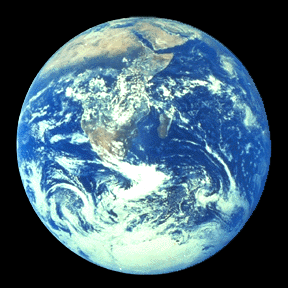 1. Life is active chemical system separated from its surroundings and out of chemical equilibrium with its surroundings. Chemical equilibrium = death.
1. Life is active chemical system separated from its surroundings and out of chemical equilibrium with its surroundings. Chemical equilibrium = death.
2. Life reproduces with heredity
3. There is variation in that heredity
4. There is evolution of populations, adaptation, and innovation
5. There are species that are reproductively isolated from other species and on their own evolutionary trajectories
6. Species make societies of kin and parasitic to symbiotic relationships with other species.
These properties of life produce the world as we now know it. As we shall see, the composition of the atmosphere, and our climate, and perhaps even the structure of the Earth's surface itself is due to life processes within the Earth System.
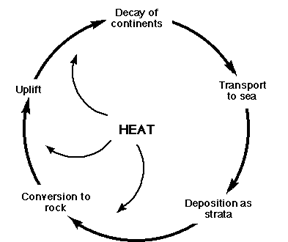 V. FIRST, LETS LOOK AGAIN AT HUTTON'S CYCLIC VIEW OF THE EARTH - Largely correct, he postulated the Rock Cycle.
This cycle produces the major rock types
V. FIRST, LETS LOOK AGAIN AT HUTTON'S CYCLIC VIEW OF THE EARTH - Largely correct, he postulated the Rock Cycle.
This cycle produces the major rock types
1). Sedimentary Rocks - Rocks formed from sediment, precipitation from solution, or the products of organisms. Examples: sandstone, rock salt, coal.
2). Igneous Rocks - Rocks formed from hot molten material. Examples: basalt, diabase granite.
3). Metamorphic Rocks - Rocks formed by the profound alteration of other rocks by the effects of heat and pressure. Examples: marble, slate, schist.
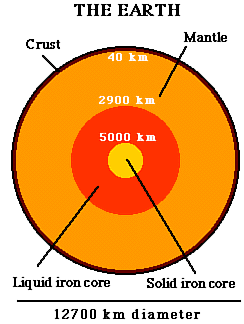 VI. We now know that the reason that the rock cycle happens as a cycle - indefinately, is because of "plate tectonics".
VI. We now know that the reason that the rock cycle happens as a cycle - indefinately, is because of "plate tectonics".
Plate tectonics are a consequence of the existence of large sheets or "plates" of more solid rock crust, more or less floating on a more liquid or plastic mantle. As a consequence of deep movements within the mantle the plates move, separate from each other and crunch into each other.
The overall structure of the earth is to have this thin rind, the crust, underwhich is the more liquid mantle of hot silicate rock, followd by liquid iron core and then a solid iron core ah the Earth's center.
We know about the Earth's interior, not through direct sampling, but rather by inferring its structure mostly by the way earthquake waves behave when passing through the earth.
Here is an easy way to remember some of the basic dimensions of the Earth - thanks to Enrico Fermi.
If we look in detail at a near surface cross section of the Earth, we see that the crust is not everywhere of the same thickness.
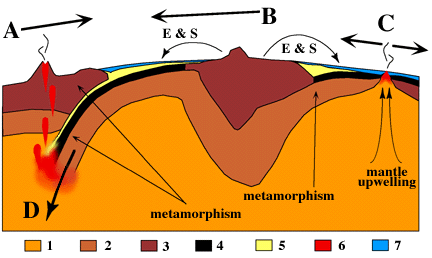
In the above diagram; 1 is asthenospheric mantle, 2, is lithospheric mantle, 3 is continetal crust (mostly granite in composition), 4 is oceanic crust (mostly basalt), 5 is sediment in the ocean basins, 6 is erupting igneous material (lava when it is at the surface), and 7 is ocean water. A, B, C, and D show the direction of plate motion. C, is an oceanic rifting zone where new oceanic crust is created by upwelling asthenospheric mantle where reaches the surface and turns horizontally. An example is the Mid-Atlantic Ridge. D. is a subduction zone, where old, cold crust sinks below an overriding plate. Erosion and sedimentation (E & S) transfers sediments weathered from the continetal crust to the ocean basins where it accumulates. At D, the old crust and the sedimnents that were deposited are being subducted. As they sink they heat up and eventually melt. The melt contains a lot of water and gas and rises to the surface to erupt as volcanoes. Mt. Fuji in Japan is such a volcano riding above the subducting Pasific plate. Another example is Mt. St Helens. Some material gets scraped off by the overriding plate and added to the continetal crust in mountains that bears the volcano. The cycle of the creation of new oceanic crust at C (a so called spreading ridge) and addition to continetal crust by scraping off material from old oceanic crust at the subduction zones (above D) and that added to continental crust by subduction produced igneous material (6 at D) about balances the loss of crust by subduction. The movement of the plates themelves is thought to be due to circulation of the asthenosphere and/or pull of the sinking, subducting plates.
The motion of the plates has occured throughout earth history and changed the configuration of the continents and oceans though time
.
VII. Thus the plate tectonic cycle is responsible for the Rock Cycle and is why it makes sence.
SEDIMENTARY ROCKS
- are produced by the burial material erroded from the continents
IGNEOUS ROCKS - are produced either by mantle upwellings, such as at spreading ridges or by subduction related volcanos
METAMORPHIC ROCKS - are produced mostly by the heating and deformation of sedimentary or igneous rocks where subduction is taking place, or where burial depths get very great
VIII. NOW THIS IS WHERE IT GETS INTERESTING - The Atmosphere composition is tied in as well to this cycle.
The Atmosphere consists of:
Mostly Nitrogen = N2 (78%)
Second Oxygen = O2 (21%)
Third Carbon Dioxide = CO2 (<0.1%) (0.0353%) now
CO2 was 0.0250% in 1800 and will be 0.0500 % in 2000 - a doubling in 100 years - all due to humans buring fossil fuels!1. O2 we need to breathe
2. CO2 plants need
CO2 is greenhouse gas
That is, it lets sulight in which converts to heat, but it does not let the heat out. This is the same principle that glass effective in a greenhouse.
IX. WHERE DOES THE O2 COME FROM AND WHAT CONTROLS ATMOSPHERIC CO2 ??
Plants through photosynthesis convert CO2 to C in Carbohydrates (CH2O) CO2 + H2O + E = CH2O + O2
(where E is energy from light)
the reverse process is respiration: we eat carbohydrates and use O2 to get energyCH2O + O2 = CO2 + H2O + E
Photosynthesis on land and in the water is important.In the world at large any fixed carbon not respired by animals, fungi, or microbes goes into sediments.
THIS CARBON THAT GETS BURIED MEANS A LOSS TO CO2 TO THE AIR AND AGAIN OF O2
X. CO2 IS ALSO CONSUMED BY THE WEATHERING PROCESS:
Water reacts with CO2 to produce carbonic acid. Carbonic acid reacts with Calcium and Magnesium silicate rocks to yield Calcium Carbonate (CaCO3 - limestone!) (or Magnesium Carbonate = MgCO3 = Dolomite) and Silicon oxide (SiO2 - quartz!).
CO2 + CaSiO3 = CaCO3 + SiO2 or
CO2 + MgSiO3 = MgCO3 + SiO2
These carbonates and the quartz get buries as sediments, mostly in the ocean basins.
THUS, WHEN THESE CARBONATES ARE BURIED IT REPRESENTS A LOSS OF CO2 FROM THE ATMOSPHERE
But where does the CO2 come from in the first place?
It comes from the lava and gasses coming up at spreading ridges and subduction zones.
In fact most of the CO2 at subduction zones comes from the metamorphism of the very materials that consumed the CO2 in the first place ‹ Carbonates reacting with Quartz, for example:CaCO3 + SiO2 = CO2 + CaSiO3
The Calcium Silicates (CaSiO3) comes back out as lava adding to continetal crust, and the CO2 comes out of the volcanos as exposive gas!
SO THE CO2 GOES IN A BIG CYCLE THAT TAKES MILLIONS OF YEARS
We can see this by adding the Carbon cycle to the plate tectonic diagram:
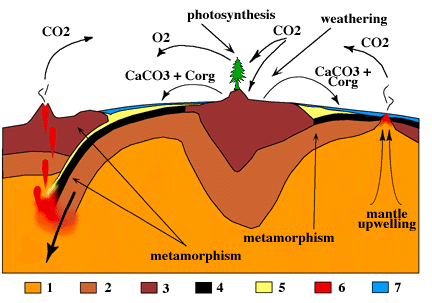
In the above diagram, Corg is organic carbon, primarily the breakdown products of carbohydrates produced by photosynthesis.
THUS, THE ATMOSPHERIC CO2 IS JUST WHAT REMAINS BETWEEN THE OUTGASSING CO2 FROM IGNEOUS AND METAMORPHIC SOURCES AND CONSUMPTION OF CO2 BY PHTOSYNTHESIS AND WEATHERING.
XI. IT IS SENSITIVE TO THE RATE AT WHICH WEATHERING OCCURS. WHAT KEEPS THE SYSTEM STABLE?
The long term carbon cycle is a system with built in feedback mechanisms. One that has long been proposed is quite simple.
Suppose the plate tectonic cycle sped up so that more CO2 was being released into the atmosphere? If weathering rate and phytosynethsis remained constant, CO2 would "pile up" in the atmosphere. But CO2 is a green house gas ‹ the more CO2 there is the more heat get trapped in the atmosphere and the warmer it gets. Chemical reactions, however, run faster as it get warmer.
So, as it gets warmer, the chemical reactions of weathering increase and more CO2 gets consumed, lower atmospheric levels. It is a negative feedback.
Suppose, now, that the plate tectonic system slow down so very little CO2 is added to the atmosphere ‹ what happens?
As it get colder because of the reduced CO2 in the atmosphere, the chemical weathering reactions slow down.
CO2 now "piles up" because its consumption has dropped.
The same kind of relationship holds for photosynthesis.If photosynthesis increased wildly for some reason, O2 would go up because more organic carbon would be buried.
But if O2 goes up things burn easily (forests are close to self-imolation all the time now). The increase in forest fires would decrease photosynthesis.
In addition to supplying O2 though carbon burial, plants also act to "fertilize" weathering. Carbonic acid comes not only from water reacting with atmospheric CO2 but even more important is the carbonic acid produced from CO2 in the soil. Soil CO2 is much more concentrated in the soil because of the respiration of plant-produced organic matter by microbes, fungi, the soil fauna, and plant roots themselves.
Thus the more land plant photosynthsis there is, the faster the weathering ‹ all again subject to negative feeback. If too much CO2 is removed it gets to cold for plants to live, plant-mediated weather decreases and the CO2 can build up again.
Doesn't this suggest that whatever effects the long-term distibution of plants will also effect atmosphereic CO2 ‹ it sure does as we will see in subsequent lectures.
OBVIOUSLY LIFE IS CRITICAL TO THE MAINTANCE OF OUR ATMOSPHERE
Now we can seen what I mean by life being an active chemical system separated from its surroundings and out of chemical equilibrium with its surroundings.
If there were no photosynthesis, all of the O2 would combine with reacive minerals and organic matter. CO2 would build up in the atmophere in exact proportion to the lack of carbon burial. We would end up with a super-greenhouse effect and end up more like Venus.
The only time orgnaims are in chemical equalibrium with their surrounding is when they are dead: thus, Chemical equilibrium = death.
Our own Green House problem from the burining of fossil fuels has a quite interesting relationship to the long term carbon cycle.
Presently nearly all of the organic carbon produced by photosynthetic organisms get respired by animals, fungi, and microbes. Only the tiniest bit get buried. But this is enough not only to maintain the O2 levels at a more or less steady state, but over geological time it is directly responsible for the formation of fossil fuels.
EVERY BIT OF OIL, GAS, AND COAL IN THE WORLD IS THE RESULT OF TINY AMOUNTS OF ORGANIC CARBON BEING BURIED BY ESCAPING BIOLOGICAL RESPIRATION.We are increasing CO2 in the atmosphere by burning the accumulated carbon of 3.5 billion years of Earth's history. This is resulting in an increase in global temperature called "
global warming". There is still much
debate however.
THERE IS A THEORY CALLED
GAIA
THAT ARGUES THAT LIFE ACTIVELY AND PURPOSEFULLY MAINTAINS LIVABLE CONDITIONS ON EARTH. THIS IS A SCIENTIFIC HYPOTHESIS PROPOSED LARGELY BY THE SCIENTISTS JAMES LOVELOCK AND LYNN MARGULIS. The theory argues that there are many feedbacks that evolved though time that regulate the abiotic processes, maintaining our planet's livability. Research on this topic has just begun.
It is an attractive proposition however, and in some circles has almost religious connotations and certainly political ones. See
A Goddess of the Earth? or Gaia, Our Living Earth.
I recommend that you surf the web for more on these subjects!
BACK TO COURSE NOTES
 1. Life is active chemical system separated from its surroundings and out of chemical equilibrium with its surroundings. Chemical equilibrium = death.
1. Life is active chemical system separated from its surroundings and out of chemical equilibrium with its surroundings. Chemical equilibrium = death. V. FIRST, LETS LOOK AGAIN AT HUTTON'S CYCLIC VIEW OF THE EARTH - Largely correct, he postulated the Rock Cycle.
This cycle produces the major rock types
V. FIRST, LETS LOOK AGAIN AT HUTTON'S CYCLIC VIEW OF THE EARTH - Largely correct, he postulated the Rock Cycle.
This cycle produces the major rock types VI. We now know that the reason that the rock cycle happens as a cycle - indefinately, is because of "plate tectonics".
VI. We now know that the reason that the rock cycle happens as a cycle - indefinately, is because of "plate tectonics".

